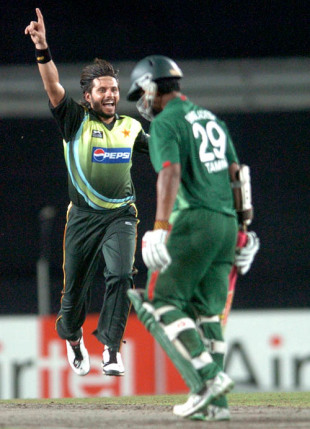Much at stake in ill-timed Asia Cup

| ||
There could not have been a worse time - literally and figuratively - to play the ninth edition of the Asia Cup, a concept that is much abused, not always without merit. And when a much-abused concept features a much-abused form of the game, it better have everything going for it.
First of all the timing of this year's Asia Cup is a worry, because it's scheduled in the months of June and July. International cricket has never been played in Pakistan during this period and that sums up the predicament of 50-over cricket, perhaps more so tournaments that feature as many minnows as they do regular teams. So why June, you ask? Easy - there just isn't any other time. As a result, all the really meaningful matches will be played in Karachi, which is expected to be the least oppressive in the summer - owing to sea breeze - and also to be least effected by the expected monsoon.
The tournament comes on the heels of a successful IPL and one look at the teams involved blatantly suggests the possibility of more one-sided, one-dimensional games such as that the recent Kitply Cup, barring the final, threw up. Fifty-over cricket never needed a bigger fillip, and the Asia Cup needs to at least make sure it doesn't go further down. For all the thrills Twenty20 has provided, 50-over cricket still offers considerably more opportunity for the classier side to prevail, the human character to unfold, the twists and turns to pan out, and that is what the tournament needs.
For all the abuse heaped on the Asia Cup, it has something going for it; something that was the basis, 25 years ago, for the formation of the Asian Cricket Council that would in turn devise this tournament. Besides promoting the game in Asia, the major purpose behind the formation of the ACC was to promote a sense of friendship and goodwill between India, Pakistan and Sri Lanka. The kind that was seen when India and Pakistan sent a joint team to Sri Lanka after Australia and West Indies refused to travel following a bomb blast just before the start of the 1996 World Cup. The kind when South Africa moved out of a tri-series in Sri Lanka in 2005, again out of security concerns, and India decided to stay on and play a bilateral series.
Now in the Asia Cup's silver-jubilee year, when few teams wants to play cricket in Pakistan, and after they've suffered major losses following Australia's pullout, and stand to lose more if the Champions Trophy is shifted elsewhere, it's the Asian countries who are trying to prove that cricket can indeed be played in Pakistan.
India, despite the blip in the final of the Kitply Cup, will go in as favourites. However, once the first three matches are out of the way they should be run close by Sri Lanka and Pakistan. For all three, there is something in the tournament and the upset win for Pakistan in Bangladesh has added the much-needed needle to the contest. India haven't won the Asia Cup since 1995; 13 years sounds like a huge interval for what is essentially a three-nation tournament. They wouldn't want to take it to 15.
For all the increased frequency of India-Pakistan contests, Pakistan are somehow still one loss to India short of a crisis. And with two matches almost assured against their archrivals, and a third one if they can repeat their Kitply Cup success, Pakistan have reason to not take this lightly. Sri Lanka, who have dipped consistently since reaching the final of the World Cup last year, are worryingly seeming to lose out on the power game - both with the bat and the ball, which is what most of limited-overs cricket in the subcontinent is about. Since making the World Cup final they have suffered one-day defeats against England at home, in the CB Series in Australia and in the West Indies. Out of their last 22 ODIs they have won eight - three of them against Bangladesh at home.
Weakened by the absence of Farveez Maharoof and Lasith Malinga and bolstered by the comeback of Sanath Jayasuriya, Dilhara Fernando and Muttiah Muralitharan, they would want to start the process of setting the record right here.
Add to this the proverbial maxim about Bangladesh, UAE and Hong Kong having to prove themselves at this level - Bangladesh under significantly more pressure than the other two - and we have a tournament that the teams should care enough about to make the viewers respond in kind.
Right now, though, the most apt definition for this Asia Cup would be a dry run for the Champions Trophy, but over the next fortnight the teams would want to make it mean more.
Sidharth Monga is a staff writer at Cricinfo
